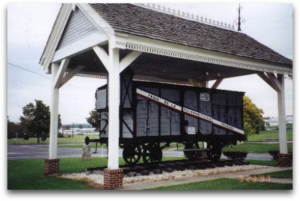Written by Ludivine Broch.
It is well-known that France and the French are haunted by the Second World War. Numerous studies have shown how memories of resistance, collaboration and deportation have risen, fallen and clashed since 1945. Yet these studies generally explore memory through the lens of political, judicial and cultural elites. How did people feel at the grassroots level? Did the French Resistance dominate their history and memory of the war, like it did at the national level?
If historians struggle to hear voices ‘from below’, the Gratitude Train – also known as the Merci Train – offers a unique lens into post-war mentalities and politics. The Merci Train to the American people was organised by the French in thanks for their aid during and after the Second World War. Considerable work gathering information on the Merci Train across all American states has been undertaken by Earl Benett who erected a very useful website. Since then, a team of history enthusiasts have continued to gather and collect information, including Alexis Mueller who manages a thriving Facebook page. On 3 February 1949, ordinary French people sent 49 boxcars to New York City containing 52,000 objects representing France (see photo below.). The boxcars and objects were shared equally amongst each state, and many are still on display to this day.

At the conference on Occupations in Total War, I gave a paper which examined a selection of 500 Merci Train objects, notes and letters of thanks sent from French donors. Indeed, this selection of sources allows us to gain unprecedented insight into ordinary people immediately after the war. I wanted to understand if, how and to what extent the occupations of both world wars featured in the Merci Train archival collections, and in the lives of ordinary people in the late-1940s. Was the obsession with the French Resistance amongst the political and cultural elite mirrored in everyday life?
My paper revealed that, after 1945, French and Americans were particularly concerned with the First World War. Indeed, if the Merci Train is traditionally framed in a Second World War narrative – that it was a gift made in light of Americans’ actions both during and after the Second World War – the objects themselves are often linked to the First – rather than Second – World War. Gifts from French people included numerous mementoes from the Great War battlefield: a gavel which was carved from a tree from Battle of Belleau Wood in 1918. A knife on which it was carved ‘Souvenir de la Somme’ (see photo below.).

Bivert Vaaille, from Bondy (Loire), donated a small bell. He had attached a note to it: ‘Bell made on the front by a poilu in the Great War 1914-18 with a fusée d’obus 77 Allemand, balle de Moser, and button taken from a German prisoner.’ A wooden cane had carved into the shaft, under the snake’s head, ‘Argonne 14 15 16’. Posters like the one advertising commemorations in 1929 which read ‘VERDUN asks FRANCE to commemorate its VICTORY * on 22 June 1929 *’ are a further reminder that the traumas of human sacrifice during the Great War were all but forgotten (see photo below).

Americans also shared a traumatic memory of loss during the Great War. In fact, The French had transported with the Merci Train a Flame that had been lit beneath the Arc of Triumph, the space where an Unknown French Soldier of the Great War is buried. ‘The cult of the unknown soldier’, as Stephane Audouin-Rouzeau and Annette Becker have underlined, ‘was the Great War’s commemorative invention par excellence’. On 5 February 1948, the flame was taken to Washington D.C. and handed over by the Association des Anciens Combattants Français to an American Legion Commander in a ‘very impressive ceremony by the Tomb of the Unknown Soldier’ in Arlington Cemetery, in the hills surrounding the American capital.
Beyond the shared sense of loss and mourning, though, the Merci Train also reveals a revival of nationalist narratives. The glorification of either French or Americans was emphasised in objects such as the bugle which sounded the Armistice in 1918, or in plaques like the one next to the Pennsylvania boxcar which explains how each French donor had expressed a ‘…depth of gratitude to America for liberating France in two World Wars’, and that the boxcars ‘…stand as a tribute to the sacrifices and bravery of American veterans who served in France in two world wars’ (see photo below).

Whilst the sacrifices and victory of the Great War are emphasised in the Merci Train, the history of occupation is completely sidelined. In fact, in this study, France’s complicated experience of occupation – first in 1914-18 and then, to an even greater extent, 1940-45 – is never mentioned. It is perhaps not surprising that the history of occupation is overlooked in order to emphasise a more glorious military history; what is more surprising is that the history of the French Resistance des not feature within it. This challenges traditional ideas we have of a resistencialist myth, of a nation obsessed with the Resistance.
The Merci Train and its objects thus confirm that commemoration of total war was very important after 1945 for ordinary people; yet it was not the Second World War, nor the Resistance, which were emphasised, but rather the First World War. Indeed, the Merci Train shows how heavily the Great War continued to feature in people’s post-war minds.
Ludivine Broch is a lecturer in the Department of the History, Sociology and Criminology at the University of Westminster and author of Ordinary Workers, Vichy and the Holocaust (Cambridge University Press, 2016).

